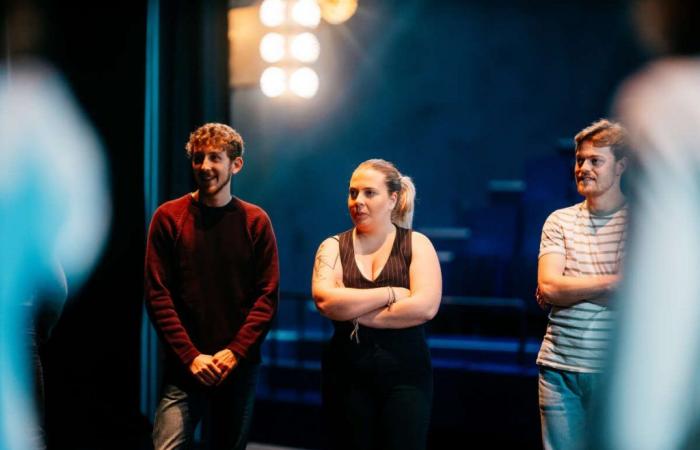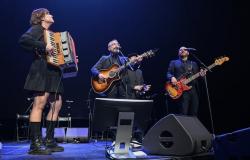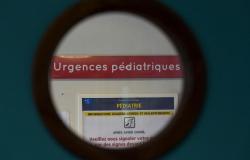Being funny can be learned. In Paris with the opening of Esar, directed by Jérémy Ferrari, but also in Avignon, Strasbourg and Lyon, schools and theaters provide training for the comedians of tomorrow.

Students from the first promotion of Esar, at the Théâtre de la Scala, in Paris. Photo Thomas O’Brien/www.thomasobrien.fr
Par Rossana Di Vincenzo
Published on October 1, 2024 at 5:11 p.m.
«Pas one more school, but a diploma school approved to train comedian artists. » Thus, the entrepreneur Frédéric Biessy presented, a few months ago, the new project that he is carrying out with his partner Mélanie Biessy – the couple notably founded, in Paris then in Avignon, the Théâtre de la Scala, to which the school. At their side, the comedian Jérémy Ferrari, recently appointed artistic director of the Higher School of Laughter Arts (Esar).
Co-directed by researcher Geneviève Meley-Othoniel, the Esar opened Monday September 30, entirely designed by the star of black humor to make it “ the school of which [il] would have dreamed when [il avait] 16 ans ». “It’s a complete theater training, focused on humor, with classes in improvisation, sports, writing, acting, rhetoric, current affairs… The idea is not to create yet another stand-up factory, but comedians who, when they leave, will have a one-hour show ready to be performed”, he adds. All for 9,200 euros per year, with twenty-six students per class, for a two-year course – including the first year at Scala Provence.
The importance of training
Esar claims above all to make humor a “art in its own right”, according to Frédéric Biessy, by professionalizing a discipline that had until then remained self-taught. Because if private and public theater training is numerous (Cours Florent, Cours Simon, national conservatories, school of the National Theater of Strasbourg or the Théâtre du Nord in Lille, etc.), humor has remained on the margins, the artists are training on their own by “testing” their jokes in comedy clubs or open mics across the country (stages accessible to amateurs and professionals in cafes, pubs, etc.).
Can we learn to be funny? For certain valve professionals, such as Guillaume Meurice, trained at the Florent course, the answer is obvious: “I always advise people to take theater classes instead, to work on Shakespeare or Racine. Working with tragedy teaches a certain rigor, a nuance. This allows us to understand that we can make people laugh in other ways, without necessarily looking for a joke. »


The Esar management team, from left to right and top to bottom: Geneviève Meley-Othoniel, Frédéric Biessy, Jérémy Ferrari and Mélanie Biessy. Photo Thomas O’Brien
However, given the success of stand-up and one-man shows in France (humor represented 27% of some 65,000 paid Music and variety performances in 2023, according to the National Music Center) and the growing number of emerging artists (each year, at least two hundred new humorists join the SACD, according to figures collected by this organization), the need for laughter training has never been so present. This is what Perrine Blondel and Mélissa Rojo, co-directors of the Théâtre La Petite Loge (Paris 9ᵉ), and Aude Galliou, co-author and director of numerous comedians, observe. In 2021, they created the Humor Academy together. ” The comical facethis power to make people laugh, we either have it or we don’t. Potential, on the other hand, needs to be worked on, molded, strengthened, made more conscious. reacts Perrine Blondel.
For three years, these three have been training aspiring artists to “understand how their future profession works” more than being “just” funny. With four modules – writing, acting, directing, career management – taught by artists and professionals in the field (the director Nicolas Vital, the clown Hervé Langlois, the author and actor David Azencot, producer Marion Gendron-Durand), their objective is that “every talent [douze étudiants par promo, ndlr] so that, after a year, with his own artistic identity, he is at ease in all contexts”, explains Aude Galliou. “On leaving, they better understand the environment in which they will operate, how and when we contact a production, a press officer, a journalist, etc. It’s perhaps pretentious, but we say to ourselves that we’re saving them almost five years.” advance Melissa Rojo.
Also read:
Stand-up: four comedians who reshuffle the cards of masculinity
A feeling shared by Lou Trotignon, a stand-up comedian who passed through the Humor Academy in 2021 and whose first show, Grouperworks well. “Before, I was very shy, I felt like I was funny almost by chance. At the Academy, I learned to bring out this comic potential. It gave me a framework, and legitimacy: I understood that I had the right to want to go on stage. »
Proof of this craze for the art of making people laugh? Humor, once shunned by classical training and conservatories, is now present in certain institutional courses. At the National Theater of Strasbourg, where director and director Caroline Guiela Nguyen (who did not wish to answer our questions) this year integrated a module around “stand-up writing”. Or at Ensatt in Lyon, under the leadership of Mireille Losco-Lena. The teacher-researcher in theater studies has been working on the subject for more than twenty years, and in 2022 set up a research and creation workshop around contemporary comic texts. “At first, I went to pick up the students. But after the first lesson, there was such a craze that, now, I refuse! »






